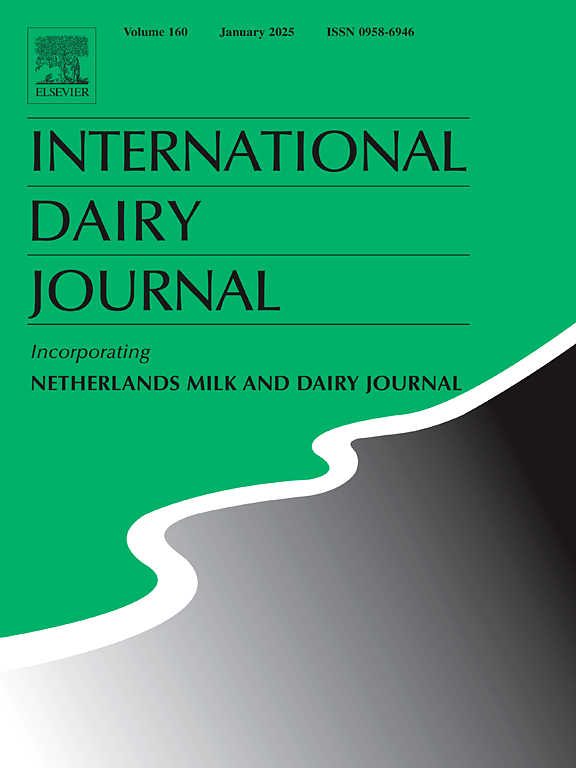Effect of sample treatment on determination of insoluble (INSOL) calcium content in the curd during Cheddar cheese-making
IF 3.1
3区 农林科学
Q2 FOOD SCIENCE & TECHNOLOGY
引用次数: 0
Abstract
Measurement of insoluble (INSOL) or colloidal calcium phosphate (CCP) is difficult during the cheese making process due to the dynamic nature of the curd samples. INSOL calcium in cheese can be measured using the cheese juice, titration, or water-soluble extraction method. This study aimed at preserving the state of calcium at the time of sampling of Cheddar cheese curd samples during cheese production using air blast, and liquid nitrogen freezing and, then, comparing results with fresh and refrigeration treatment. To get desired buffering peak, samples quantity was based upon standardizing protein content of various samples which enabled accurate measurement of INSOL calcium. Buffering peak pH shifted towards lower side (4.8) and INSOL Ca higher side post whey drainage. The INSOL Ca content of the curd samples treated with fresh, air blast and liquid nitrogen treatment was statistically similar suggesting either of these methods could be a viable option to preserve the state of calcium for accurate measurement in the cheese curd. We believe that our method offers convenience and cost effectiveness to the cheese industry as compared to the other methods available in literature. In future our method can be compared with other methods used for determination of INSOL Ca.
切达干酪制作过程中样品处理对凝乳中不溶性钙含量测定的影响
由于凝乳样品的动态特性,在奶酪制作过程中很难测量不溶性磷酸钙(INSOL)或胶体磷酸钙(CCP)。奶酪中的INSOL钙可以用奶酪汁、滴定法或水溶性萃取法来测定。本研究旨在利用吹风和液氮冷冻的方法保存切达奶酪凝乳样品在奶酪生产过程中取样时的钙状态,并将结果与新鲜和冷藏处理进行比较。为了得到所需的缓冲峰,样品的数量是根据各种样品的蛋白质含量进行标准化的,这样可以准确地测量INSOL钙。在乳清排水后,缓冲峰pH向较低的一侧移动(4.8),INSOL Ca向较高的一侧移动。用新鲜、空气和液氮处理的凝乳样品的INSOL Ca含量在统计学上是相似的,这表明这两种方法中的任何一种都可以作为一种可行的选择,以保持凝乳中钙的状态,以便准确测量。我们相信,与文献中可用的其他方法相比,我们的方法为奶酪行业提供了方便和成本效益。该方法可与其它测定INSOL Ca的方法进行比较。
本文章由计算机程序翻译,如有差异,请以英文原文为准。
求助全文
约1分钟内获得全文
求助全文
来源期刊

International Dairy Journal
工程技术-食品科技
CiteScore
6.50
自引率
9.70%
发文量
200
审稿时长
49 days
期刊介绍:
The International Dairy Journal publishes significant advancements in dairy science and technology in the form of research articles and critical reviews that are of relevance to the broader international dairy community. Within this scope, research on the science and technology of milk and dairy products and the nutritional and health aspects of dairy foods are included; the journal pays particular attention to applied research and its interface with the dairy industry.
The journal''s coverage includes the following, where directly applicable to dairy science and technology:
• Chemistry and physico-chemical properties of milk constituents
• Microbiology, food safety, enzymology, biotechnology
• Processing and engineering
• Emulsion science, food structure, and texture
• Raw material quality and effect on relevant products
• Flavour and off-flavour development
• Technological functionality and applications of dairy ingredients
• Sensory and consumer sciences
• Nutrition and substantiation of human health implications of milk components or dairy products
International Dairy Journal does not publish papers related to milk production, animal health and other aspects of on-farm milk production unless there is a clear relationship to dairy technology, human health or final product quality.
 求助内容:
求助内容: 应助结果提醒方式:
应助结果提醒方式:


